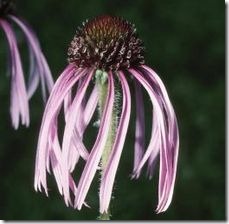Purple coneflowers are equally at home in rural wildflower gardens and urban borders. At 4 to 5 feet tall, these heat-tolerant perennials add color to gardens from mid- to late-summer. The central seed cone, which gives the purple coneflower its name, persists into winter and provides visual interest for humans and food for finches. Purple coneflowers are propagated by division and direct-sowing. They readily self-sow as well.
Dormant Seeding in Wild-Flower Gardens
-
Pale purple coneflower (Echinacea pallida) is often used in wildflower gardens, whether sown as alone or mixed with other wildflower seeds. For monoculture (single-cultivar) plantings, prepare the seeding area by removing all weeds and cultivating the soil lightly.Do not fertilize the first year unless the soil is poor and a soil test shows low phosphorus and potassium levels.
The best germination rate occurs when you sow the seeds between November and March while they are dormant. The seeds need a period of cold stratification in a moist environment at 35 to 40 degrees Fahrenheit. It takes 60 to 90 days for the seeds to break dormancy under these conditions. Sow dormant seeds any time from November to March at a depth of 1/8 inch.
Cold-Stratifying Inside
-
To cold-stratify pale purple coneflower seeds inside, combine sand with the seeds in a 2:1 ratio and place the mixture in a plastic bag. Add enough water to dampen the sand, seal the bag and place it in the refrigerator. Leave the seeds in the refrigerator for 60 to 90 days, checking the moisture level weekly and adding water as needed. Plant the seeds in the garden after the weather has warmed.
Direct-Sowing in Urban Gardens
-
Purple coneflower (Echinacea purpurea) can be direct-sown in the garden without cold stratifying. They prefer neutral, well-drained soil with a pH between 6 and 8. Purple coneflower is a sun-lover, but the plants will tolerate part shade. Prepare the soil by digging in compost, leaf mold or other organic matter. Once soil temperatures reach 55 to 70 degrees Fahrenheit, direct-sow the seeds on the surface of the soil and water lightly to keep the seeds moist. Once they begin to germinate in 10 to 20 days, cover the seeds with 1/8 inch of soil. The germination rate is typically 70%, so plant enough seeds to offset the potential loss. Thin seedlings so the mature plants will be 18 to 24 inches apart.
Self-Sowing
-
Purple coneflower tends to self-sow readily, which works to your advantage in a wildflower meadow. When planting Echinacea in urban settings, either plant them at the back of a border where they won’t hinder other plants as they multiply or pull volunteer seedlings to keep them contained.


Deprecated: strpos(): Passing null to parameter #1 ($haystack) of type string is deprecated in /home/agriviek8Qv/agriviet.net/public_html/wp-includes/comment-template.php on line 2522